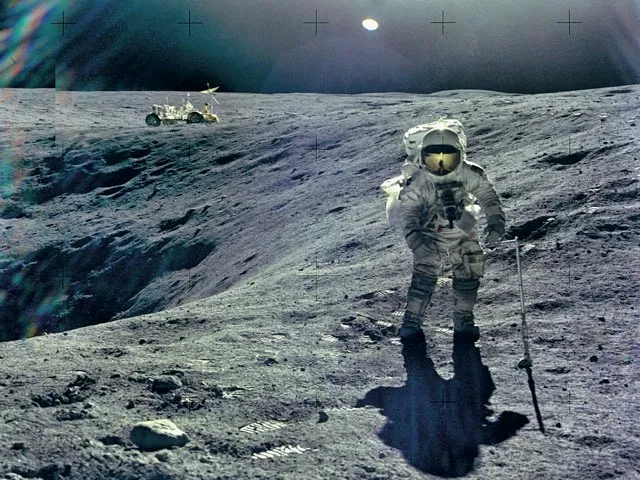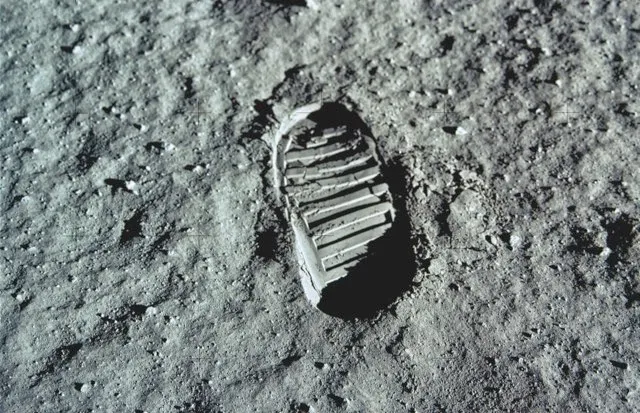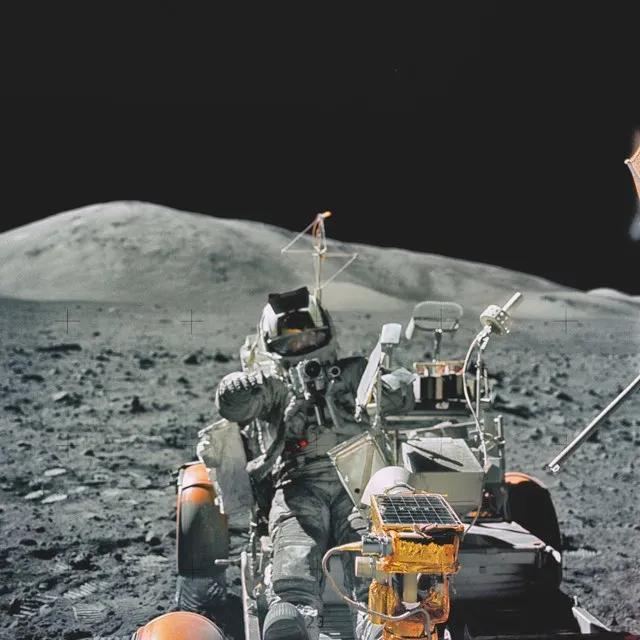On 14 December 1972, Gene Cernan, the mission commander for Apollo 17, stood at the foot of the lunar landing module and said, “…I take man’s last step from the surface, back home for some time to come – but we believe not too long into the future.”
He was the 12th, and last, person to walk on the Moon, and clearly anticipated a relatively prompt return. That was not to be, as ambitions – if not funding – turned towards Mars. No one has walked on the Moon since.
Read more about future Moon missions:
- Inside China’s plans to build a lunar base
- Lunar Orbital Platform-Gateway: the next space station will orbit the Moon
- Welcome to Asgardia – the cryptocurrency-funded nation with eyes on the Moon
Now the tide is turning. After years of interest in the Red Planet, the scientific, astronautical and entrepreneurial community is uniting behind a push to return to the Moon, both to continue the research that was started by the Apollo missions and to prepare for future exploration.
We speak to five leading voices from the worlds of astronomy, philosophy, science and technology to understand why we should return to the Moon.
Prof Lewis Dartnell – Astrobiologist, University of Westminster, UK

The only astrobiological reason that you need to justify a return to the Moon is that it preserves ancient rocks from the Earth that have been splashed up by big asteroid strikes. And here I want to tip my hat to Prof Ian Crawford, of the University of London, for these ideas.
The Earth is an active and dynamic place. That’s important in the emergence of life and its long-term evolution over billions of years. Yet the planet’s dynamism poses a problem when you are trying to find the earliest traces of life on Earth, because most of the planet’s crust has been destroyed by plate tectonics [the shifting and recycling of the Earth’s surface rocks].
Read more about the Apollo Moon landing:
- Apollo 11 Space Mission: 60 seconds from disaster
- Apollo Mission Patches: Badges of honour
- Everything you ever wanted to know about the Apollo programme
The Moon, on the other hand, is a stable, static and even boring place in the sense of active processes. If there were a way to get ancient rocks from Earth up onto the Moon, they would stick around for a long time, as they wouldn’t be eroded or destroyed by plate tectonics. This is where asteroid strikes come in. If chips of the Earth got blown off our planet and up into space, the Moon would sweep up that material and preserve it.
So it stands to reason that there are probably ancient Earth rocks on the Moon that could contain microfossils or chemical fossils that would tell us about the origin of life on Earth.
The problem is that it is going to be quite hard to find these flecks of Earth. You might start looking for hydrated minerals, which are ubiquitous on Earth but very rare on the Moon.
Any material splashed up would be distributed randomly across the Moon but you could look for places where that material has been preserved.

The main problem of preserving biosignatures in space is the cosmic radiation. These high-energy particles travel at close to the speed of light, and are destructive when they hit cells of organic molecules. So we might want to target ancient lava flows on the Moon that may have covered up any Earth rocks that were lying on the surface at the time, and are now protecting them beneath several metres of rock.
There would be the issue of mapping to identify and date the lava flows, and then sending a mission to drill on a lava flow of the correct age.
It would be hard work. It would be like looking for a needle in a haystack without the use of a magnet. On the other hand, the pay-off would be enormous. You would be finding Earth rock that is far older than anything found on our planet. So there is a lot to gain from doing this.
Naveen Jain – Co-founder and chairman, Moon Express

If I were to paraphrase President John F Kennedy, “We choose to go to the Moon, not because it is easy but because it is great business.”
When Moon Express lands on the Moon, we will become the first private company to do so. That is quite symbolic of things to come. To me, the next set of superpowers are likely to be entrepreneurs, not nation states.
The time is now right to use technology to solve the grand challenges facing humanity. I argue that landing on the Moon could potentially bring world peace. We fight over land, water and energy, yet all we have to do is look up into space and there is an abundance of these things.
It is only a matter of time before we get hit by a massive asteroid. If we live only on Earth, then humans are going to become extinct like the dinosaurs. Wouldn’t you prefer to have some entrepreneur creating an underlying infrastructure so that we can really become a multi-planet society?
Listen to brilliant podcasts about the Apollo Programme:
- Science Focus Podcast|Why is the Moon landing still relevant 50 years on? – Kevin Fong
- Science Focus Podcast|The mindset behind the Moon landing – Richard Wiseman
- Radio Astronomy Podcast|Talking Apollo moonwalkers with author Andrew Smith
- History Extra Podcast|The race to the moon with historian Kendrick Oliver
What we will be doing is creating the underlying infrastructure of space. We think of ourselves as the iPhone of space. Back in 2008, Steve Jobs launched the iPhone and the App Store. Obviously he had a seriously good idea of what people could do with the device but couldn’t possibly have anticipated the success that both were spurred on to by certain killer apps.
Now that we have created this iPhone for the Moon with Moon Express, we have to ask ourselves what is going to be its killer app. Will it be something that Moon Express will create, or is it something that we’ll allow other entrepreneurs to do? It could be bringing stuff down to Earth, or using stuff to create habitats on the Moon.
My gut reaction is that bringing lunar rocks to Earth could be the most beneficial task initially. We could disrupt the diamond industry. Diamonds were never the symbol of love until the 1950s. De Beers created a brilliant ad campaign to sell that idea. If you’re an entrepreneur against a monopoly you don’t fight it, you change the game. So, we bring back the Moon rock and we change the paradigm: it’s not enough to give her a diamond, if you love her enough you give her the Moon.
Prof David Rothery – Professor of planetary geosciences, Open University, UK

Lunar exploration has been going on fairly vigorously for 20 years, but it hasn’t involved people since the last Apollo mission. We currently have a series of unmanned missions around the Moon, including NASA’s GRAIL (Gravity Recovery And Interior Laboratory) and China’s Chang’e 4, which became the first mission to successfully land on and begin exploring the far side of the Moon in January 2019. So the unmanned exploration is happening but there’s only so much you can do remotely.
You do need to get people among the surface materials as well – both for seeing the geology at close quarters and for taking measurements that you can’t take from orbit. Apollo left four seismometers on the Moon for recording moonquakes. They weren’t brilliant but it’s the only other planetary body that we’ve got seismology for. The data the seismometers collected told us about the Moon’s interior but they were turned off after a few years to save money.
Read more about the people behind the Moon landing:
- Small steps: How NASA prepared for the first moonwalk
- Wernher von Braun: Director of the Marshall Space Flight Center/Saturn V Chief Architect
- Ladies who launch: the women behind the Apollo Program
A few more seismometers on the lunar surface would give us great insight into the Moon’s interiors. But you have to be on the surface to deploy them so that you can couple them properly to the ground.
Also there are heat flow experiments. We don’t know the rate at which the Moon’s internal heat is leaking out towards the surface. They tried to measure it during the Apollo missions but it didn’t work. They had trouble getting a good hole into the ground. So we’re guessing at the lunar heat flow until we can go back, drill a hole and insert some equipment. And you’re probably going to need people to do something that fiddly.
Getting equipment to work on the Moon is a challenge we have yet to overcome. The lunar dust rises and falls with day and night because of electrical static charges, so you can get dust flecks into your mechanisms and that can lead to problems. But if you’ve got people there you can overcome those problems. They can deploy fresh equipment and drill holes.

They can also wander around making geological observations. The orange-coloured lunar soils were spotted by an astronaut from one of the later Apollo missions. He thought it was something rusty but it was orange beads from an explosive volcanic eruption. If you’ve got trained people at the location, they’ll spot the unusual things.
The Mars rovers – impressive though they have been – haven’t gone as far as astronauts that drove the Moon buggies around. It’s a lot more expensive to get people there, but they get a lot more done.
I was a kid when the Apollo missions happened and I thought it was the future, I thought that was what we were going to be doing: putting people in space. It was inspiration for me. There is a benefit from just seeing people up there because it inspires the next generation of scientists. I don’t think you can decouple that from the scientific facts that you are going to find out. As well as the mysteries that you’re going to unravel, you’re also going to be inspiring the next generation of scientists.
Gonzalo Munévar – Philosopher, Lawrence Technological University, Michigan

Philosophy has to do with understanding our relationship with the world. In that sense, it is inextricably bound to science. It seems to me that the philosophical concern of this is what happens if we go to places like the Moon.
We can look at what has already happened. By going to the Moon, with Apollo and other missions, we have come to understand better what the Earth is like. So knowledge of the planetary system and of the cosmos gives us knowledge of the Earth. It is not just idle curiosity; it is something that, in the long run, affects us because it makes us understand our place in the Universe, and once we understand the Universe – and this is the point of practically all knowledge – we can then interact with that world better.
For us, understanding what the Earth is like is extremely important because the Earth has changed. To understand that, we need to know what kind of planet Earth was when it formed and what kind of forces have acted upon it. One of the most important objects that we have to study is the Moon.
Read more about the Apollo programme:
- The Space Race: how Cold War tensions put a rocket under the quest for the Moon
- How to argue with a Moon landing denier
- “We choose to go to the Moon”: Read JFK’s Moon speech in full
By going to the Moon only a few times we accumulated an extraordinary amount of knowledge about what the Earth was like because the Earth and Moon apparently formed together. Even if this is not the case, it is still important to find out how the Earth and the Moon came to be together like they are.
The lack of atmosphere and activity on the Moon means its surface has a permanent record of collisions with comets and asteroids [in the form of craters], of a size and number that we do not have on Earth. The Moon knows so much.
To understand the Earth is to understand the Earth as a planet, which means to understand what planets are, how they formed, how they evolved and how they relate to the Sun and so on. The Moon is so close to us. So going back to it is going to help us improve our understanding of our place in the Universe.
Exploring with humans is a lot more expensive and dangerous than doing it with machines but in the long run we have to do it anyway. It also provides other benefits because humans are much more adaptable than robots.

Steve Squires, the person in charge of the Mars rovers, once said that he was very pleased with everything one of them had done in the previous six months. But he also pointed out that an astronaut could have done it all in a single day.
It is great that we have those machines, but eventually we need to be out there. I also think it is good to have adventures as a species so that more people can be inspired by them and participate in their own.
Going to the Moon the first time around was so exciting. Going back will give us the opportunity to go to other, more exciting places.”
Commander Chris Hadfield – Astronaut, first Canadian to walk in space

Exploration is what teaches us things. It allows us to make educated and informed decisions. If we never explore then we cannot improve and expand. Exploration is fundamental to human nature. It is why we learn to walk before we learn to talk, because we have to explore to become well-formed human beings. And we have to have exploration as part of our society in order to be a well-formed society.
There are so many precedents in history. I look at the businessmen of England in 1496 who were hesitating about what to do in the wake of Columbus’s discovery of America, “Well, okay he’s discovered a new world, but should we do anything? Is there a quick buck to be made?”
But then a few far-sighted people in Bristol and a few in London said, “I think exploration is going to lead to good things. It is going to take a while to get any money back but let’s fund John Cabot.” And Cabot’s 1496 voyage was a complete bust. Cabot launched out of Bristol in one ship and didn’t know what he was doing. But he learned a lot.
He came back, set out again in 1497 and then discovered Newfoundland. He opened North America to England and began the great English exploration over the next 300 years.
A lot of the world is uninhabitable without technology. But once you develop the right sort of technology, then living in those places can have enormously valuable consequences for humankind. The real question is at what point does our technology become advanced enough to make exploration economically viable? How much can be done by sensor equipment alone and how do we determine when people should go?

We can stick a weather station in Antarctica and it will tell us the air temperature and the windspeed. But that is such a tiny piece of the information that we need to know about Antarctica. Most of the data needs to be inquisitively pursued and robots are terrible at doing that.
So should we forsake lunar exploration for Martian exploration? They’re both largely unknown. The real question is how do we not blow it? How do we not make fatal mistakes? We’re going to get it wrong. On my three visits to the International Space Station, things went wrong all the time. You would have a hard time counting the number of times that we needed to be saved by bringing replacement equipment up from Earth.
If we go to Mars for a six-month voyage, then we are basically trapped in our own ignorance. It could end up being like the Franklin expedition, where you think you know what you’re doing but you inadvertently kill everybody. We have to recognise that failure is a big, big part of success, so you have to give yourself the opportunity to fail without destroying the entire effort that you are trying to accomplish.
Follow Science Focus onTwitter,Facebook, Instagramand Flipboard
